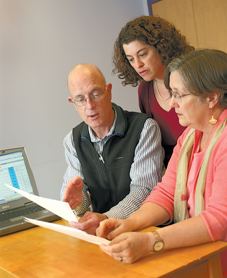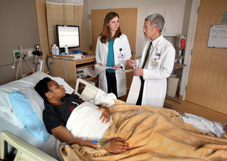Practice uses ACP survey for peer review, quality improvement
True North Health Center in Maine surveyed every patient who came through their doors from March through May last year to let each if its 28 practitioners know outcomes for each provider. Proprietary surveys are expensive, so they turned to ACP's tools. The results helped those performing best to teach their peers about best practices.
Where: True North Health Center, Falmouth, Maine
The issue: Evaluating individual clinicians and targeting areas for improvement in the practice overall by customizing ACP's patient satisfaction survey.
Background

True North is a nonprofit, multispecialty integrated health center and research organization whose 28 practitioners include physicians, advanced practice nurses, mental health practitioners, pharmacists, chiropractors, life coaches, fitness trainers, naturopaths and other credentialed integrative practitioners. Conducting research that helps patients achieve optimal health and well-being is a key component of the center's mission.
In 2008, the organization sought a research tool that would compare its outcomes with those of more traditional health care settings. B. Joseph Semmes, ACP Member and director of research for True North, selected the ACP patient satisfaction survey.
“As an ACP member, I had always found their product standards to be extremely high,” he said. “I viewed the survey as a tool that would impose a very low burden for practitioners and patients, and one that could help us significantly improve the practice. And it's free; most surveys on the market are expensive.”
How it works
The ACP survey poses 29 questions in seven categories ranging from ease of access to the physician's interpersonal skills (view or download the survey online ). True North used the entire ACP survey plus an additional 16 questions relating to demographics, the use of supplements and prescription medication, and a variety of health outcomes, including sleep, exercise, weight and smoking.
True North piloted the survey as a component of practitioner peer review by sending it to all the active patients of the center's medical director, asking them to consider the previous two years' visits.
“She was excited about having her practice assessed because she was going through a reengineering of her practice model at the time, and really wanted additional input,” said Thomas Dahlborg, executive director of True North. “Then we continued the pilot with two additional practitioners before we officially began to include the survey as part of the peer review process.”
After implementing some practice changes based on the initial pilot surveys, True North gave the survey to every patient who came to the center from March through May of 2009. Using the Likert scale already built into the ACP survey (five choices ranging from “strongly disagree” to “strongly agree”), Mr. Dahlborg developed an outcomes assessment tool that allowed each practitioner to see how his or her patients answered specific questions. The analysis also allowed the center to compare and contrast the performance of different practitioners, such as naturopaths and physicians, on specific health outcomes.
The challenges
“We didn't see an off-the-shelf compilation and analysis tool, so we built it ourselves,” Mr. Dahlborg said. “This gave us more familiarity with the data, which is a positive, but it was very time-consuming.”
Results
“We found our complementary practitioners were much more successful in helping people sleep than our practitioners who were doing the cutting-edge chronic disease management or the more allopathic care,” said Mr. Dahlborg. “On the other hand, the people doing the cutting-edge chronic disease management did far better on getting people to eat better. Now, through work circles, the practitioners are learning best practices in these and other areas.”
The group paid particular attention to responses that pertained to the patient relationship. “One provider found that her patients felt her advice was sometimes complex and hard to digest,” said Dr. Semmes. “She brought in an RN to assist her in explaining some pretty complicated approaches to nutritional change. That has improved how her patients view her explanations.”
In its analysis of health outcomes, the group found that patients had improved their level of fitness but not as much as they had improved in other key areas such as nutrition and sleep patterns. “We made a group decision to bring in an exercise and fitness trainer,” said Dr. Semmes. “We haven't seen the data from surveys taken after he joined the group, but this is an example of how we use the feedback to get a sense of where we're missing things and how we can improve.”
Lessons learned
“Number one is, just do it. It's so critically important,” said Mr. Dahlborg. “Just getting people through the door doesn't fulfill the commitment to significantly improving the quality of health care provision, the health of individuals and the health of communities. Number two, identify your goals and incorporate them. If your goal is simply [assessing] access, this tool off-the-shelf is great. If it's more, take the opportunity to customize it.”
How patients benefit
The survey results helped True North identify and address potential threats to their patients. “People often don't understand how dangerous supplements can be, particularly when they're mixed with prescription drugs,” said Mr. Dahlborg. “When we found that 86% of our respondents were using supplements, we confirmed the need to provide a drug supplement interaction program to educate patients and alert our practitioners to really follow up on those questions around supplement usage.”
Next steps
True North is still in the process of identifying and implementing new initiatives based on the three-month 2009 survey of patients. The group plans another three-month reassessment in 2010 to measure changes in areas targeted for improvement. As practitioners come up for their scheduled peer review, their patients are now asked to complete surveys based on their experiences and outcomes during the past two years, according to Mr. Dahlborg.
Words of wisdom
“Patient satisfaction is more likely to be achieved when the perceived relationship rises above the norm,” said Dr. Semmes. “Emotional intelligence, mindful listening, trust, all shift the therapeutic encounter to a higher level. The ACP survey, particularly with its request for patient comments, can be a helpful tool in improving outcomes by improving the therapeutic encounter.”




